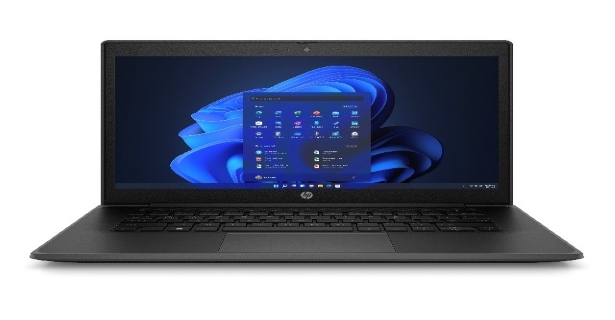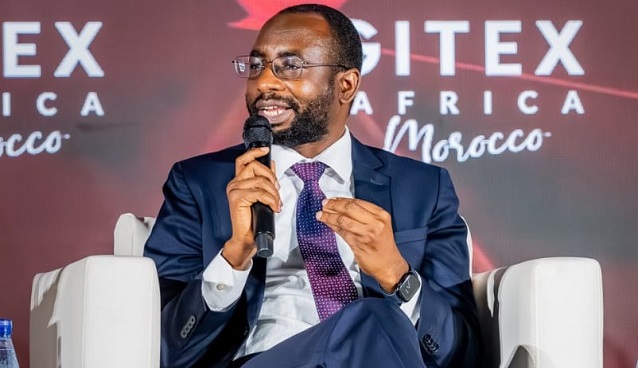E-Business
HP Introduces Durable Devices for Blended Learning Environments

HP Inc. has introduced HP Fortis laptops, a new portfolio of PCs built to withstand the rigours of education environments.

Teaching and learning has forever changed. Before the pandemic, student PCs typically stayed in the classroom for occasional use.
Today, learning is happening beyond just the classroom including the playground, on the bus, and at home.
The PC is a critical tool for digital learning and students want devices that stand up to daily wear and tear, help them connect to the digital classroom, and make it easier to get more done.
“While hybrid work is the new standard for business, blended learning is the new standard for education. This requires technology with increased durability, enhanced connectivity, and large screens so content can be accessible and engaging from wherever learning happens,” said Bill Avey, General Manager and Global Head of Education, Personal Systems, HP Inc.
“Designed with features that reduce accidental drops, keep keys and ports intact, stand up to heavy wear and tear, and make it easier to clean and sanitise, HP is committed to providing students with the devices and PC experiences they need to be successful in these new learning environments.”
The new PCs include the new HP Fortis portfolio which embodies the strength and durability learners need to help withstand drops, resist spills, and keep keys where they belong: on the keyboard. The textured surfaces make it easier for students of all ages to grip and handle the lightweight devices.
The reinforced power and USB-C® ports limit damage from accidentally tugged cables, while the mechanically reinforced corners and co-molded rubber trims absorb shocks and reinforced hinges reduce stress on the hinges from repeated opening and closing.
The full-skirted anchored keyboards prevent keys from being removed when students are fidgeting and may want to pick at them during class. The keyboard also resists spills up to 350 ml/11.8 oz.
With more students going back to the classroom, it is important to keep devices clean. The chassis, keyboard, and display for the devices can be wiped down using commonly available household disinfecting and cleaning wipes. For enhanced safety and protection, the devices feature a new metal shield that helps protect the battery from external damage from daily drops or tumbles.
Built for the greater demands being placed on today’s students, the HP Fortis 14 devices feature 14” diagonal displays giving students large visual screen space to stay productive – whether it’s taking notes while watching a lecture or creating visual stories with ease.
Large screen space gives students the freedom to engage content while consuming it at the same time. Students can also see their work clearly with optional bright anti-glare displays.
The HP Fortis 14” G10 Chromebook is purpose-built for cloud-native learning. Powered by Intel® processors with optional 4G LTE for reliable connectivity, the Chromebook allows students to access their classroom from almost anywhere.
The 180-degree lay-flat hinge combined with the 88-degree wide-viewing angle HD camera and dual mics provide an excellent collaborative learning experience. The integrated HP Privacy Camera provides peace of mind to protect users from malicious surveillance, while Chrome Education Upgrade makes the device easy to deploy and simple to manage.
The HP ProBook Fortis 14” G9 and the HP ProBook Fortis 14” G10 help students to confidently move through their day. With HP ProBook Fortis 14” G9 – Powered by Intel processors with Windows 11 Pro, Windows 11 Pro Education or Windows 11 SE, students can easily collaborate and reliably access assignments with Wi-Fi 6 and optional 4G LTE connectivity.
HP ProBook Fortis 14” G10 – Powered with Intel 12th Gen Intel® i3/i5 processors and Windows 11 or Windows 11 Pro Education, enables students transition quickly between writing documents, running STEM applications, editing video, and more.
The latest in connectivity – Wi-Fi 6E – allows students to cut through crowded networks, while the battery learns students’ work patterns and optimises power consumption with intelligent charging. HP Wolf Security for Business makes it easy for IT to protect student devices with a hardware-enforced, always-on, resilient defence.
The HP Pro x360 Fortis 11” G9 and HP Pro x360 Fortis 11” G10 embrace the different ways learning happens. The 360-degree design gives students the freedom to choose the mode that best suits them and their assignment.
The optional world-facing 5 MP cameras and rechargeable pen with reinforced tip allows students to create, capture, and draw in laptop, tablet, tent, stand, or book mode. The rechargeable pen is stored and charged in an optional water-resistant garage so it’s ready to go whenever creativity strikes.
HP Pro x360 Fortis 11” G9 – Powered by Intel processors with Windows 11 Pro, Windows 11 Pro Education or Windows 11 SE, students can access assignments and apps seamlessly with Wi-Fi 6 and optional 4G LTE.
HP Pro x360 Fortis 11” G10 – Powered with Intel 12th Gen Intel® i3/i5 processors and Windows 11 Pro or Windows 11 Pro Education, the device helps students tackle demanding assignments, like editing videos for media class or analysing lab data.
Wi-Fi 6E delivers fast, dependable network connections for learning in the cloud. HP Wolf Security for Business provides a resilient defence against malware and hacking. Equipped with intelligent charging, the device’s battery learns students’ work patterns and optimises power consumption.
The HP Fortis 11” G9 Q Chromebook, powered by the robust Snapdragon® 7c compute platform, is exceptionally equipped for cloud-native mobile learning and provides secure and reliable access to the classroom.
This Chromebook is HP’s thinnest and lightest Fortis device built for the rigors of today’s students and providing ultimate portability. It boots in seconds so students can spend more time learning and less time waiting. The device’s 4G LTE connectivity makes education more accessible and equitable for all students to learn from virtually anywhere.
The HP 320 FHD Webcam and HP 325 FHD Webcam are easy-to-use all-in-one webcams for users everywhere. Enjoy crisp images with 66-degree wide angles that offer full HD at 1080p and 30 fps video quality for a natural conversational feel.
The webcams are easy to set up with USB-A, have 360-degree rotation for varying positions, and feature a removable lens cover for privacy.
As part of HP’s Sustainable Impact strategy, HP is aiming to empower millions of people with what they need to participate in the digital economy.
HP is committed to enabling better learning outcomes for 100 million people by 2025 and accelerating digital equity for 150 million people by 2030.
E-Business
Gold Hits Record High Amid U.S. Dollar Weakness and Trade Tensions

Gold prices surged to a fresh record high on Monday, April 21, while the dollar weakened and global stock markets presented a mixed picture, as concerns mounted over former President Donald Trump’s escalating tariff strategy and his ongoing confrontation with the Federal Reserve.

Amid subdued activity due to continued Easter holiday closures in several markets, investors focused on the potential fallout from Trump’s latest trade moves and looked ahead to key economic data releases later this week that may shed light on the broader impact of the evolving U.S.-led trade war.
The administration’s tariff campaign has triggered swift responses from major economies. While some, like Japan, are reportedly seeking accommodations to ease Washington’s trade levies, China issued a sharp warning to governments not to negotiate at the expense of its interests. A spokesperson for China’s commerce ministry said Monday that appeasement and compromise would fail to win peace or respect, calling on nations to avoid sacrificing broader interests for temporary gains.
Beijing’s tone contrasted with Trump’s comments last Thursday in which he signaled ongoing discussions with China, expressing optimism about reaching a deal. However, tensions remain high, with China facing tariffs of up to 145 percent on some goods, and retaliating with duties of 125 percent on U.S. exports.
The growing uncertainty over the global economic outlook has driven investors toward safe haven assets. Gold climbed above $3,384 per ounce, buoyed both by the geopolitical instability and a weakening U.S. dollar. The dollar’s decline has been exacerbated by concerns over Trump’s comments directed at Federal Reserve Chair Jerome Powell, who warned that the tariffs could lead to a temporary rise in inflation and downplayed prospects for interest rate cuts.
Trump criticized Powell for his remarks and hinted at the possibility of removing him from office, stating: “If I want him out, he’ll be out of there real fast, believe me.” Powell has maintained that he will not step down and emphasized the legal foundation of the central bank’s independence.
The dollar fell against major currencies, with the yen and euro gaining strength. France’s finance minister Eric Lombard said Trump’s tariff policies had already damaged the credibility of the U.S. currency and warned that undermining the Federal Reserve would further shake investor confidence. Chicago Fed President Austan Goolsbee underscored the importance of central bank independence, calling it a near-universal principle among economists.
Asian stock markets reflected the uncertainty, with Tokyo’s Nikkei falling 1.2 percent, while gains were seen in Shanghai, Seoul, Singapore, Manila, and Jakarta. Oil prices declined amid renewed fears over global demand, with West Texas Intermediate and Brent crude both dropping 1.7 percent.
Investors are now watching closely for April manufacturing data from key economies, which are expected to provide early signals about the tangible effects of the tariffs. Analysts warn that U.S. fiscal and monetary policy are increasingly being viewed as volatile geopolitical forces rather than stable economic anchors. Stephen Innes of SPI Asset Management said the reputational damage to the U.S. economic brand is becoming entrenched, with global markets and allies adjusting expectations accordingly.
E-Business
Google Blocks 5.1Bn Harmful Ads in 2024, Suspends 39m Accounts

Google’s 2024 Ads Safety Report revealed how artificial intelligence is now a frontline defense against harmful online content, blocking 5.1 billion ads, restricting 9.1 billion more, and suspending over 39 million advertiser accounts, most before a single ad was shown.

The crackdown comes as scams become more sophisticated, with many leveraging AI-generated content or impersonating public figures.
Google’s advanced AI models, powered by Gemini, helped detect fraud faster than ever, spotting signs like stolen payment info, fake businesses, or coordinated scam networks.
In Africa, including Nigeria, the impact is especially important. Impersonation scams and misleading political ads remain a major concern.
In response, Google updated its Misrepresentation policy, deployed a team of 100+ global experts, and took down over 700,000 scam-related advertiser accounts, leading to a 90 percent drop in reported impersonation scams.
With nearly half the world voting in 2024, Google also removed over 10 million election-related ads for failing to meet transparency rules requiring verified identities and clear sponsorship disclosures.
In his reaction, Alex Rodriguez, general manager for Ads Safety at Google, said these numbers show what AI can do when it’s focused on safety.
“We rolled out more than 50 AI model upgrades in 2024, helping us act faster and smarter—stopping threats before users even saw them,” Rodriguez added.
While AI handles large-scale enforcement, human reviewers now focus on complex cases.
Google continues working with global regulators, industry partners, and organizations like the Global Anti-Scam Alliance to keep ahead of evolving threats.
E-Business
DG NITDA Tasks Africa to Lead the AI Revolution Through Strategic Leadership, Inclusive Innovation

The Director General of the National Information Technology Development Agency (NITDA), Kashifu Inuwa CCIE, has urged industry leaders across the continent to integrate Artificial Intelligence (AI) into their business, organisational, and operational models to unlock new opportunities, redefine leadership, and drive smarter decision-making toward making Africa deeply rooted in AI-driven innovation.

Inuwa made this call when he spoke on “Harnessing AI for Strategic Leadership” during a panel session at the Main State of the GITEX Africa 2025 held in Marrakech, Morocco.
The aim of the panel session was essentially to explore how data-driven and intelligence-led strategies can transform business models, optimise resources, and unlock new opportunities through AI-powered processes across various nations.
Speaking to an international audience of policymakers, technologists, and investors, the DG positioned Africa, particularly Nigeria as a rising force in the global AI landscape, championing a people-first and strategy-led approach to AI development and governance.
The DG argued that to be effective in today’s dynamic environment, leaders must evolve into AI-driven leaders and leverage technology not just as a tool, but as a partner in decision-making.
“AI is shifting the skills we value today, as well as the processes we use to do our daily work, so to drive strategic leadership, you need to be an AI-driven leader and find a way to use AI as a tool to create co-intelligence whereby you bring people and computers to work together to deliver your strategic vision as a leader,” he noted.
While urging leaders to combine AI with the unique strengths of their teams to deliver real business value, Inuwa stated that “Strategy must always come first, and technology second.”
He outlined four principles for effectively utilising generative AI which are inviting AI to the tale, maintaining human oversight, designing models with guardrails, and adopting a mindset of continuous improvement.
Inuwa explained that AI is invited to the table by giving it a role in organisational tasks, maintaining human oversight to correct bias and misjudgment, designing guardrails to ensure privacy ethics, and inclusivity, and adopting a mindset of continuous improvement by treating today’s AI as the least capable version that can be used.
He however warned against the risks of deploying AI systems built on data that fails to represent the diverse realities of global societies. Stressing the need for digital visibility of all cultures and citizens, he cautioned that if data doesn’t see a community, the system won’t see it either.
Introducing NITDA’s approach to governance in regulating AI through the Regulatory Intelligence Framework that is anchored on the 3 pillars of Awareness, Intelligence and Dynamism.
“In our approach to regulating AI in governance, we have a framework we call Regulatory Intelligence Framework, which as a regulator we need to be aware of the environment, we need to be dynamic because things change, and we also need to be intelligent. We need to know the data and make sense out of it,” he disclosed.
“Then we have 2 approaches, the first one is a rule-based where you can come up with certain guidelines and expect people to comply with them and we have a non-rule based, which allows them to build use cases, and based on those use cases, put the guard rails and agree on the best practices, which is always the best when it comes to AI governance,” he added.
Envisioning Africa’s AI future in the next 5 years, Inuwa painted a visionary picture where the continent will integrate AI into solving real-world challenges in every economic sector thereby leapfrogging development gaps.
Inuwa firmly averred that by augmenting human capability with AI, the continent can unlock unprecedented levels of innovation, efficiency, and inclusive growth.
“We missed the first, second, and third industrial revolutions, but this fourth one, we must lead it and not just follow.” He concluded.
Other industry leaders who shared their experiences and insightful ideas at the panel session were the Special Envoy on Technology, Republic of Kenya, Philip Thigo, CEO Pesalink, Gituku Kirika, and the Head of Africa, Open AI, Emmanuel Lubanzadio.

 Telecom2 days ago
Telecom2 days agoMTN Nigeria Takes Broadband Services to the Next Level with FibreX Launch

 News2 days ago
News2 days agoSERAP Files Lawsuit Against NBC Over Ban on Eedris Abdulkareem’s Protest Song Tell Your Papa

 Telecom18 hours ago
Telecom18 hours agoDigital Transformation Remains Africa’s Gateway to Economic Advancement – Adumike

 Telecom18 hours ago
Telecom18 hours agoPAFON 2.0: Experts Discuss Pathways to Boost Financial Inclusion in Nigeria

 E-Financial2 days ago
E-Financial2 days agoFCMB Group Redefines Corporate Storytelling with The Power Of The Group TVC

 E-Financial18 hours ago
E-Financial18 hours agoCBN, NGX Group Defend Economic Reforms at Nasdaq

 General News18 hours ago
General News18 hours agoEFCC Clarifies SCUML Certificate Misuse amid CBEX Ponzi Scheme Scandal

 General News18 hours ago
General News18 hours agoFlashChange Partners Ruth Foundation to Empower Vulnerable Children in Alimosho with Skill Acquisition

























